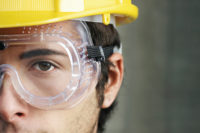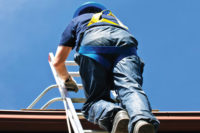My first on-the-job experience with the power of electricity happened back in the 1980s. A young 27-year-old was a regular customer in our rigging shop. Suddenly he went missing. I didn’t see him for months. One day he came in; I was shocked. He had two hooks instead of hands. As we talked he told me he had grabbed a live cable and blew his arms off to the elbows. I guess the good thing was he was alive and coping with his situation. He was working.
By the late ’90s we were building fall protection equipment. An electric company in the south used harnesses made only of nylon. No polyester. Why?
The nylon didn’t melt into the flesh as bad in the event of a flash. They requested one other special feature: a metal tag in the chest area. Its purpose: the workers’ social security number was inscribed on it for ID of the body. Apparently even the teeth would melt in a flash.
What about other workers?
In August 2014, OSHA issued a final rule updating 29CFR.269, a standard covering the construction and utilities industries. It had remained unchanged for about 40 years. The standard may not have changed but the world and the workplace bear little resemblance to the mid-’70s.
Some of the new guidelines were delayed until 2015 although enacted in 2014—29 CFR 1910.269 and CFR Part 1926 Subpart V. OSHA responded to commonly asked questions in a published document.
General questions
1. Who has to follow the final requirements?
Employers who operate or maintain electric power generation, transmission, or distribution lines or equipment must follow §1910.269. Employers with employees who perform construction work on electric power transmission or distribution lines or equipment must follow Subpart V. Note that “construction work” includes the erection of new electric transmission and distribution lines and equipment, and the alteration, conversion, and improvement of existing transmission and distribution lines and equipment.
2. What are the costs and benefits associated with the proposed standard?
OSHA estimates that the final rule will prevent approximately 20 additional fatalities and 118 additional serious injuries annually. OSHA estimates the total annualized cost of compliance with the final rule to be between about $47 million and $50 million. A full description of the costs and benefits of the final rule is available in the Federal Register notice for the final rule at Section VI, Final Economic Analysis and Regulatory Flexibility Analysis.
Fall protection questions
1. What are the different types of fall protection equipment the standard requires?
Depending on the circumstances, the standard requires one of three types of fall protection:
• Personal fall arrest system. A system used to arrest an employee in a fall from a working level.
• Fall restraint system. A fall protection system that prevents the user from falling any distance.
• Work-positioning equipment. A body belt or body harness system rigged to allow an employee to be supported on an elevated vertical surface, such as a utility pole or tower leg, and work with both hands free while leaning.
2. What forms of fall protection must employers use to protect employees working from aerial lifts?
The standard requires employers to protect an employee working from an aerial lift using one of the following:
• A personal fall arrest system or
• A fall restraint system.
3. What forms of fall protection must employers use to protect employees working from a pole, tower, or similar structure?
The standard requires employers to protect an employee working at heights of more than 1.2 meters (4 feet) on a pole, tower, or similar structure using one of the following, as appropriate:
• A personal fall arrest system,
• Work-positioning equipment,
• A fall restrain system, or
• Other fall protection meeting Subpart D of OSHA’s general industry standards or Subpart M of OSHA’s construction standards, as applicable. A guardrail system meeting one of those standards is an example.
4. Must qualified employees climbing or changing location on poles, towers, or similar structures use fall protection?
Generally yes. Starting April 1, 2015, the standards require qualified employees climbing or changing location on poles, towers, or similar structures to use fall protection, unless the employer can demonstrate that climbing or changing location with fall protection is infeasible or would create a greater hazard than climbing or changing location without it. (Note that “climbing” includes going up or down the pole, tower, or other structure.)
Arc flash protection questions
1. What must an employer do to protect employees from hazards posed by flames and electric arcs?
In general, the employer must:
• Assess the workplace to identify employees exposed to hazards from flames or from electric arcs;
• Make reasonable estimates of the incident heat energy of any electric-arc hazard to which an employee would be exposed;
• Ensure that employees exposed to hazards from flames or electric arcs do not wear clothing that could melt onto their skin or that could ignite and continue to burn when exposed to flames or the estimated heat energy;
• Ensure that the outer layer of clothing worn by an employee is flame resistant under certain conditions; and
• With certain exceptions, ensure that employees exposed to hazards from electric arcs wear protective clothing and other protective equipment with an arc rating greater than or equal to the estimated heat energy.
2. What are the deadlines for compliance with the arc-flash protection requirements?
The employer must assess the workplace for arc-flash hazards by the effective date of the final rule. In addition, the employer must ensure that employees do not wear clothing that could melt onto their skin or that could ignite and continue to burn by the effective date of the final rule. By January 1, 2015, the employer must make reasonable estimates of incident energy. Finally, the employer must provide protective clothing and other protective equipment meeting the arc-flash protection requirements of the final rule by April 1, 2015.
3. Must employers pay for the flame-resistant and arc-rated clothing and other arc-flash protective equipment required by the standard?
Yes. As required by OSHA’s general rules on employer payment for personal protective equipment (29 CFR 1910.132(h) and 29 CFR 1926.95(d)), employers must pay for the flame-resistant and arc-rated clothing and other arc-flash protective equipment that the electric power generation, transmission and distribution standards require.
4. Has OSHA provided any guidance on how to perform the required assessment and how to estimate incident heat energy?
Yes. Appendix E to the standard provides tables listing incident heat energies for common exposures found in electric power transmission and distribution work. Employers may use these tables to estimate incident heat energy under the exposure conditions covered by the tables.
5. Has OSHA provided any guidance on how to select the protective clothing and equipment required by the standard?
Yes. Appendix E to the standard provides guidance on:
• How to select clothing that does not ignite,
• How to select protective clothing with an acceptable arc rating, and
• When the standard requires arc-rated head and face protection
How does fall protection equipment achieve a fire rated and ARC rated status?
Let’s take a look at the ANSI Standard 887 ASTM F 887-05. What is its scope?
“The standard covers acceptance testing of climber straps, body belts, position straps, harnesses and shock absorbing lanyards used by workers in climbing poles, towers and other structures. Minimum performance criteria for arc resistance of harnesses and shock absorbers are included for workers who may be exposed to thermal hazards of momentary electric arcs or flame.”
The ASTM F 887 standard deals particularly with full body harnesses and lanyards worn by workers for fall protection. The objective is to verify by testing that fall protection harnesses and shock absorbing lanyards will continue to perform as intended after being exposed to a severe electric arc flash. Testing is performed in two consecutive steps: first, an arc flash exposure and next, by dynamic drop testing.




